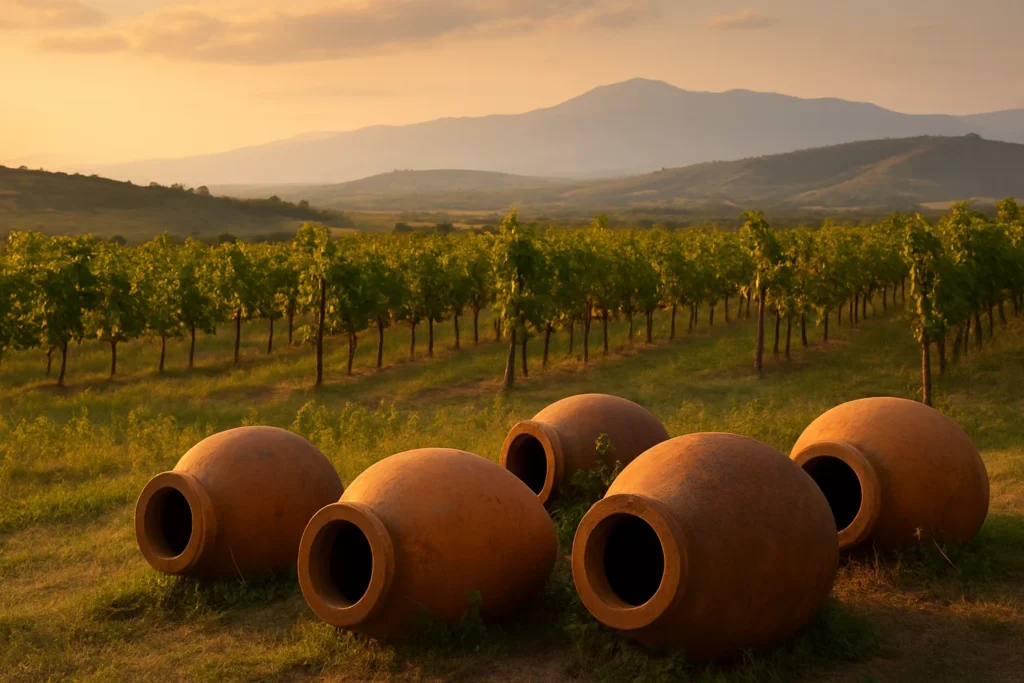Prologue: The Genesis of the Vine
In the shadow of the majestic Caucasus Mountains, where the continent of Europe gives way to Asia, lies a land of profound natural beauty and even deeper historical significance: Georgia. It is here, amidst lush valleys and winding rivers, that the very story of wine began. Recent archaeological discoveries near the capital city of Tbilisi have unearthed the indisputable evidence—8,000-year-old grape pips and the telltale chemical traces of fermented grape juice found in ancient clay vessels. These artifacts paint a picture of a civilization that was not just among the first to encounter wine, but to master it. This story predates the invention of writing, the wheel, and the rise of organized agriculture in many parts of the world, positioning Georgia as the undisputed cradle of winemaking.
The ancient Georgians did not merely stumble upon fermentation by chance; they deliberately cultivated and perfected it. The wild vines that still grow prolifically throughout the nation’s forests bear genetic markers that prove their domestication over generations. At the heart of this ancient practice was the qvevri (kweh-vree), a technological marvel of the ancient world. This massive, egg-shaped clay vessel was not just a container; it was a sophisticated piece of technology for controlled food preservation, one that predates the Egyptian pyramids by millennia.
Chapter 1: The Sacred Vessel – The Art and Science of the Qvevri
The Birth of a Tradition
The qvevri is far more than a simple clay pot; it is the embodiment of a sacred craft, a vessel of earthly wisdom. Each massive clay vessel, which can range from a modest 100 liters to a colossal 3,000 liters, represents hundreds of hours of painstaking labor by skilled craftsmen. Known as qvevrisnobebi, these master potters use techniques that have been passed down through generations, unchanged for centuries. The process begins with special, mineral-rich clay mined from specific Georgian regions. This clay is then carefully mixed with crushed limestone and sand to achieve the perfect porosity—a crucial element for the natural micro-oxygenation of the wine.
The craftsmen employ a coil-building method to create the vessel’s distinct egg shape, ensuring structural integrity and a uniform thickness of 3-5 cm. The interior is then meticulously coated with beeswax, not just for sanitation but to protect the wine from the clay’s flavors while still allowing for that gentle, life-giving oxygen exchange. The exterior is treated with a lime wash, a traditional method to prevent bacterial contamination.
The Science Behind the Magic
Modern research has begun to unravel the scientific genius behind the ancient qvevri method, validating the wisdom of tradition with empirical evidence.
- Thermal Stability: Buried up to its neck in the earth, the qvevri is insulated from temperature swings, maintaining a constant, ideal fermentation temperature of 13-15°C. This allows for a slow, gentle fermentation that preserves the delicate aromas and flavors of the grapes.
- Micro-oxygenation: The porous clay of the vessel permits a minimal, controlled exchange of oxygen. This allows the tannins to soften and the wine to mature gracefully, creating a textured and complex wine that is both robust and elegant without any woody notes.
- Natural Clarification: The conical, egg-like shape of the qvevri is a marvel of fluid dynamics. It allows solid particles—such as skins, seeds, and yeast—to settle naturally at the narrow bottom of the vessel, resulting in a wine that is naturally clarified and ready for consumption without filtration.
- Microbial Diversity: The long history of use of a qvevri creates a unique, living microbiome within its walls. Centuries of continuous use allow for the buildup of beneficial yeasts and bacteria that impart distinctive characteristics to the wine, flavors that are simply impossible to replicate with modern technology.
As Dr. Lisa Granik MW, a leading expert and author, explains: “The qvevri isn’t just a tool—it’s a living, breathing microbiome that imparts flavors and character impossible to replicate with modern technology.”
Chapter 2: The Golden Age of Georgian Wine
Wine in the Medieval World
During Georgia’s Golden Age, which spanned the 11th to 13th centuries, wine transcended its role as a mere beverage to become central to the nation’s identity, its culture, and its economy. The court of the legendary Queen Tamar exported qvevri wines along the famed Silk Road, where they were highly sought after and commanded prices that rivaled Persian silks. Monasteries such as Alaverdi and Ikalto became not just centers of religious worship but also hubs of viticultural innovation, where monks meticulously documented and cultivated hundreds of indigenous grape varieties. The medieval Georgian epic poem, “The Knight in the Panther’s Skin”, is a testament to this deep cultural connection, containing over 100 references to wine, including a beautiful passage: “He poured wine like sunlight into the qvevri of his heart, where it aged into wisdom.”
The Royal Vineyards and Sophisticated Practices
The kings of Kakheti were far ahead of their time, developing sophisticated vineyard management systems. They implemented intricate terracing on steep hillsides to prevent soil erosion and maximize sun exposure. They practiced careful grape selection, dedicating specific varieties for different purposes—table wines, sacramental wines, and aged reserves. Early irrigation techniques using clay pipes were also in use, showcasing a remarkable understanding of water management. Archaeologists have uncovered royal wine cellars containing hundreds of qvevris, some still holding the faint, ghost-like traces of 800-year-old wine, a silent testament to a glorious past.
Chapter 3: The Soviet Suppression: An Era of Silence and Resilience
The Industrialization of Tradition
With the 1921 Soviet annexation, a dark period descended upon Georgia’s winemaking heritage. The systematic dismantling of traditional practices began with the collectivization of family vineyards in 1928. Small-scale, artisanal winemaking was deemed inefficient and bourgeois. The state mandated a shift to mass production, focusing on sweet, fortified wines designed for the vast Soviet market. By the 1950s, many of the country’s unique grape varieties were replaced with high-yield hybrids, and by the 1970s, only a dozen state-approved varieties remained, a devastating blow to a country that had historically cultivated over 500. Ironically, Joseph Stalin, a Georgian himself, was a paradox; he championed industrial production while privately maintaining a personal cellar of traditional qvevri wines.
The Underground Keepers
Despite severe penalties and the threat of imprisonment, the spirit of Georgian winemaking could not be fully extinguished. A few brave souls became the silent keepers of the flame. The Chavchavadze family, for example, secretly maintained their tradition by hiding their qvevris in the estate’s tunnels. Monk Father Gerasim continued monastery winemaking under the guise of “religious necessity,” while in villages like Napareuli, underground cooperatives secretly produced traditional wine for local consumption, ensuring the techniques and stories would not be lost forever.
Chapter 4: The Phoenix Rises – Georgia’s Wine Renaissance
The First Rebels of the 1990s
As the Soviet Union crumbled, a new dawn broke over Georgia. The first to act were a handful of intrepid pioneers. In 1991, twin brothers Gela and Gia Gamtkitsulashvili became symbols of this rebirth, literally digging up their family’s buried qvevris and beginning the arduous process of revival. The movement was internationalized in 1995 when John Wurdeman, an American artist, fell in love with the tradition and established the now-famous Pheasant’s Tears winery. The first exports of qvevri wine to France began in 1998, and by 2000, the Georgian Wine Association was formed to protect and promote traditional methods.
UNESCO Recognition: A Turning Point (2013)
The culmination of this revival came in 2013 with the inscription of qvevri winemaking on UNESCO’s Intangible Cultural Heritage list. This global recognition was a watershed moment, not just for its prestige, but because the application process itself forced Georgians to meticulously document the very techniques that were nearly lost—from the precise clay composition ratios to the regional variations in qvevri shapes and the ancient vineyard songs sung during harvest.
Chapter 5: The New Generation of Vintners
Urban Returners and Modern Innovators
Today, the winemaking renaissance is being led by a vibrant new generation. Young Georgians, many of whom have returned from cities like Tbilisi or from abroad, are bringing a fresh, modern perspective to an ancient craft. Nino Gvantseladze, a former architect, now combines the wisdom of qvevri technology with modern biodynamic farming. Irakli Cholobargia, a former tech entrepreneur, is using AI to analyze ancient fermentation techniques and optimize quality. There’s even a “Qvevri Punk” movement, where young vintners experiment with traditional amber wines in modern cocktail culture.
Global Ambassadors and International Acclaim
The world’s most influential wine critics and professionals are now champions of Georgian wine. Alice Feiring, a leading voice in the natural wine movement, has declared it “the most authentic wine culture on earth.” Esteemed critic Jancis Robinson has included Georgian varieties in her comprehensive Wine Grapes encyclopedia, and Michelin-starred chefs from New York to Tokyo are proudly featuring qvevri wines on their menus, a testament to their rising status in the global fine dining scene.
Chapter 6: The Science of Tradition: Ancient Wisdom Meets Modern Research
Validating the Old Ways
Recent scientific studies are providing powerful validation for these traditional practices. Emory University has found that qvevri wine contains unique probiotic strains, suggesting potential health benefits. Research from the Georgian Technical University has confirmed that clay fermentation increases the concentration of resveratrol, a powerful antioxidant. Moreover, European Wine Labs have confirmed that these wines have significantly lower histamine levels, making them more tolerable for many people.
Genetic Preservation: Safeguarding the Future
The Georgian National Vine Collection is a vital institution dedicated to safeguarding the country’s astonishing genetic diversity. Since 1991, they have rediscovered and cataloged 525 indigenous grape varieties. They are actively propagating 120 near-extinct grapes and studying 40 wild vine species for their resilience to pests and climate change, ensuring that Georgia’s viticultural future is as rich as its past.
Chapter 7: Beyond Wine: The Broader Cultural Impact
The Supra Revival
The winemaking renaissance has breathed new life into other cultural traditions, most notably the supra, or traditional feast. New schools are teaching the intricate art of being a tamada (toastmaster), and regional toasting sequences are being rediscovered and celebrated. This revival has led to a flourishing food scene where modern chefs are creating fusion cuisine that pairs beautifully with the unique profiles of qvevri wines.
Artistic and Creative Inspiration
The culture of wine continues to inspire artists and creators. The qvevri shape appears in modern sculptures and installations, and the new generation of Georgian poets is using wine metaphors in their work. Electronic artists are even sampling traditional vineyard work songs, weaving the sounds of the past into the rhythms of the present.
Chapter 8: Challenges of Success
The Double-Edged Sword of Popularity
With global acclaim comes new challenges. The soaring popularity of qvevri wine has led to counterfeit versions flooding international markets. The over-commercialization of traditional feasts threatens to dilute their spiritual and cultural significance. Moreover, land prices have surged, making it difficult for young, local Georgians to afford new vineyards.
Climate Threats
The changing climate presents a formidable threat. Georgians are experiencing earlier harvests, now 2-3 weeks sooner than their grandparents’ time, a clear sign of rising temperatures. New pests are moving north, and water scarcity in traditional growing regions is becoming an increasing concern, pushing winemakers to adapt with resilience and ingenuity.
Chapter 9: The Future in Clay: A Vision of Innovation
Technological Synergy
The future of Georgian winemaking is a blend of ancient wisdom and cutting-edge technology. Researchers are using 3D mapping to document ancient qvevri cellars, and blockchain technology is being explored to authenticate genuine qvevri wines. Augmented reality vineyard tours are also on the horizon, allowing visitors to visualize historical winemaking techniques as they walk through the vineyards.
Global Expansion and Collaboration
The Georgian winemaking revival has inspired a global movement. Qvevri workshops are now being held from California to New Zealand, and international collaborations—such as Georgian-Italian amphora wine projects—are pushing the boundaries of what is possible. The unique properties of clay fermentation are even being studied for potential applications in space research under microgravity conditions.
Epilogue: The Eternal Vintage
As the sun sets over the Alazani Valley, painting the Caucasus Mountains in hues of gold and purple, the clink of qvevris being cleaned after the harvest echoes through the tranquil air like ancient bells. In Georgia, wine was never merely a beverage; it is a sacred liquid, a distillation of history, a communion with ancestors, and a promise to future generations. The story continues in every vineyard where grandparents teach their grandchildren the old ways, in every qvevri being carefully buried for the next vintage, and in every glass raised around the world in celebration of this extraordinary and enduring tradition. As winemaker Giorgi Barishvili toasts, “Gaumarjos! To victory—not over others, but over time itself.”



